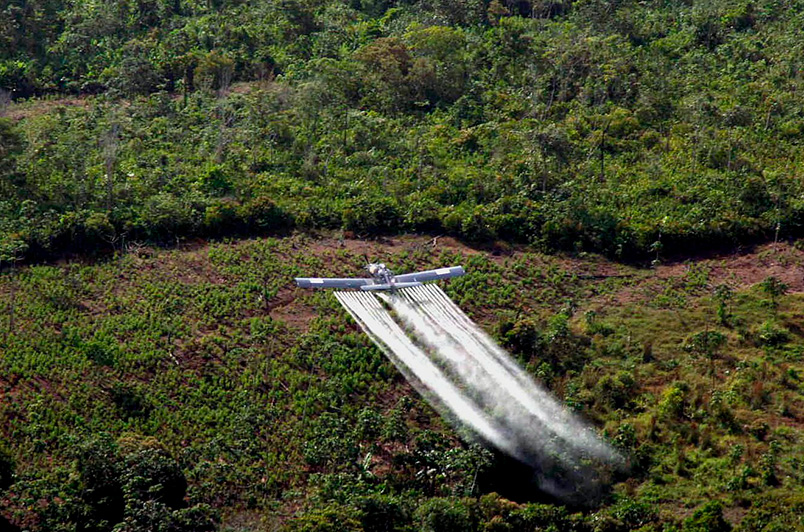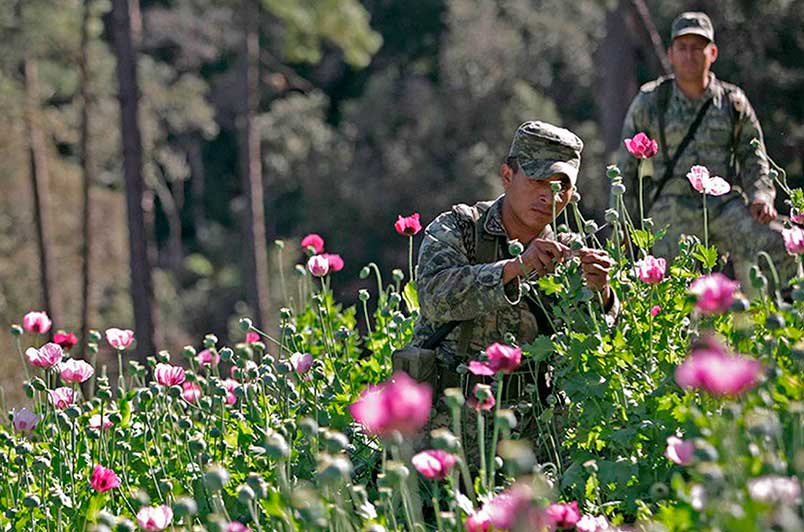Benito Díaz
Glyphosate is an herbicide that was highly popular in the late 90s. Its effectiveness was backed by the Colombian government as they used it to eradicate the illegal crops of cannabis and coca. Glyphosate turned into a tool in the war on drugs. Nowadays, the government is trying one more time to use it, ignoring the native communities and the environmental consequences.
This substance is mass-produced by Monsanto, an agrochemicals and biotechnology company which was bought by the pharma giant Bayer in 2018. The company has been accused more than once of creating some of the most polluting and dangerous chemicals in history, like Glyphosate or the Agent Orange, another herbicide used as a weapon by the US in the Vietnam war. Glyphosate, commercially known as RoundUp, is used mainly in transgenic crops of soy, cotton, and corn. According to certain sources, the real toxicity of Glyphosate has been successfully hidden for years, in the interest of these multinational companies and thanks also to the absence of scientific studies.
Currently, this product is banned in many countries of Asia and the EU, but not in Spain, despite the tests that show manipulation of the results in the scientific studies carried out by the same Monsanto to prove the safety of their product, in 1984 and 1991. Moreover, the multinational has been sanctioned as well for misleading advertising, when it claimed that glyphosate was biodegradable. It has been proved not only that it is not biodegradable, but that it seriously damages the soil and, therefore, the ecosystem and people’s health.
We talk to Luis Felipe Cruz, lawyer and sociologist and an investigator for the centre of juridic studies “DeJusticia”. This is a group located in Bogotá devoted to fighting for human rights and defending the rule of law, promoting actions of social change through investigations and public policy proposals.

Introduction to Glyphosate
“Glyphosate is a broad-spectrum herbicide, that works by inhibiting an enzyme that allows photosynthesis. That way, when the substance is applied over a plant, the plant dies”, explains Cruz, an expert in living conditions in farming territories and the impact of drug policies in the access to social rights in coca-growing communities. “This substance was used in Colombian drug policy: there are registered data as early as 1974. In a first moment it was used to fumigate the cannabis crops in Sierra Nevada, in the Atlantic coast of our country. Afterwards, it was used to spray some poppy crops (opium) in the mid-90s in certain southeast areas. In 1994, a national program for the fumigation of glyphosate was created specifically for coca crops. This plan, called the Eradication of Illicit Crops through Glyphosate Program (PECIG) has been valid since that year”, Cruz exposes.
The main argument in favour, he tells us, is that it is an effective measure to control large illicit plantations of cannabis, coca or poppy: “From 1994 to 2015, around two million hectares of these crops were fumigated from small airplanes. Nevertheless, after multiple international denounces, the scientific study of the herbicide’s effects was boosted, specifically its possible effects over the reduction of coca plantations”.
“Ultimately, that depends on the composition of the soil, the amount of nutrients and the ways in which substances are processed in that medium, through lixiviation processes. What is known now is that glyphosate can remain up to six years in the substrate, and can filter to subterranean aquifers, polluting waters of public consumption”, he warns.

Massive spraying consolidates in 1994
Luis Felipe Cruz comments that the decision of starting to spray the fields with glyphosate was definite by 1994, after some attempts during the 80s. These are times of neoliberal breakthrough and search of economic growth, in contrast to the situation of poverty of the rural and agrarian communities. “This context is one in which the crops rise since both the cartel of Cali and the cartel of Medellín nationalise the crops of coca leaf. In the decade of the eighties, they had brought the leaf from Bolivia and Peru, to have it processed in Colombia, produce the cocaine and send it to the USA. This was Pablo Escobar’s business. But in the 90s, what they do is grow their own crops, and Colombia starts to be first world producer of the two”, explains Cruz, pointing out as well that it is all related to the escalating violence because of the armed conflicts in Colombia. “Fumigations with glyphosate are the precedent to the worsening of paramilitary violence, guerrilla incursions and interventions of the state (police, army). Glyphosate was used as a strategy of direct confrontation against the social base of the Revolutionary Armed Forces of Colombia (FARC), to damage the economy of that guerrilla, especially in areas of Putumayo, Huila, Cauca, Meta and other spots in the Southeast”.
Rural and native communities
“Glyphosate cannot be directed at a specific target. During fumigation, the wind can take it to places where there might not be coca crops necessarily. This is one of the main reasons why the communities were affected. Another reason is that in Colombia the right to prior consultation, to previous consent, was not respected. If this was not enough, glyphosate has very harmful effects not only on plants, but also on insects, bees, and amphibians, destroying the trophic chains, in addition to generating deforestation on large jungle areas and destroying even the bacteria of the soil. All this makes the land go sterile, and, paradoxically, in those places only coca can be grown”, claims Cruz. All of this would affect the communities living in those areas, forcing them to move in search of new farming lands.
Constant threat
“From 2015 on the WHO’s International Agency for Research of Cancer has filed glyphosate as a ‘probable cancer-causing substance’. It brought attention over an herbicide extensively used in all kinds of crops, globally. This caused fumigations to stop, not only in Colombia, in application of the precautionary principle: they ceased its use until proven that the substance was harmless. Nevertheless, two or three years ago, the Colombian government decided to resume fumigations, reopening the debate on the effectiveness of the strategy, which, even though it might cause this or that disease, does help reducing the coca crops. On the other hand, there is evidence that the spraying is not efficient”, says the expert.
This brings us back to the arguments in favour of glyphosate, like its ability to reach the coca plantations, frequently far away areas, unreachable for the terrestrial eradication groups, who pull the whole plants off the ground. “To eradicate an area, we need groups of a hundred people to root out the whole hectare and transport the remains to guarantee they are secure. This system does not seem efficient for the government, who leans towards fumigation. Some armed groups hide anti-personnel mines in the cultivated land or nearby. That has caused numerous casualties in the army and amongst the farmers who work the land, paid by the militia. In the present moment, there are more than 20.000 hectares of coca, reinforcing the governments’ position”, claims the lawyer, who points out that the strategy is not only costly in human resources, but also from an economic standpoint. Effectively fumigating a hectare of coca costs 72 million Colombian pesos, because the spraying needs to be repeated around thirty times.
Alternatives
Cruz gives two public policy solutions that could be implemented. “First, a large policy of substitution of illicit crops and illicit uses of coca crops, using strategies of alternative development. Farmers and coca growers are economically marginalised people who see in these crops or in trafficking a way to work and to stay in the territories, areas which are of difficult access, have no power lines, and are far away from the markets. Therefore, if someone grows bananas, yucca or potatoes, they face problems to commercialise the product because of the price of transportation. These people then opt for coca, a much more profitable product in terms of selling price”, he comments. Ultimately, it is a matter of offering these families an alternative that would grant them regular and legitimate income so they can support themselves. “There is a downside to this solution, it does not tackle the root of the problem, the illegal markets. In Colombia, illegal groups come and go between gold markets, coca, wood markets, etc. These versatile dynamics of the armed groups make it difficult for just one line of action to end the problem”.
The second one of Cruz’s solutions is the legalisation of drugs. This would tackle the proliferation of high-profit illegal markets that enables the armed groups, who end up ruling over large territories. “The discussion over the coca leaf and its derivates, the discussion over the regulation of cocaine at a national and global level, is something of great interest to us. We see it as a structural, long-term way out, as well as the human development of these territories, even though it is a way out that is more difficult to consolidate. Thus, we only approach the alternative development as a harm reduction strategy after the current drug policies”.
Hidden agenda
“From my perspective, we need to keep in mind that many of the territories where they have proposed to resume fumigation with glyphosate are places where extractive projects are planned, whether they are mining, energy or oil plans. There is the theory, and research needs yet to be done, that glyphosate could be used as a strategy of territorial evacuation. It would expel poor communities, who suffer violence from the state or the armed groups, so that these projects could take form when there is no one left to oppose them”, says Cruz, who does not want people to forget the coca border is rich in coltan, gold and other raw materials. “It is not absurd to think that those interests exist. There is also the interest of selling a product and imposing a dialectic of terror over the population in these territories and reaffirming the political line of the current government”.
More information about the DeJusticia research on their website.
